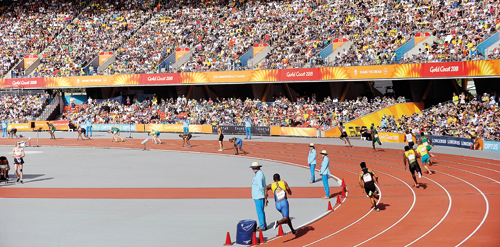Three elevens saved a moment of time

This picture taken by cameraman Thusith Wijedoru of the National Olympic Committee shows the awesome ambience depicted while at the 4x100 heats at the Carrara Stadium in the Gold Coast. This stadium was not built anew. It was only refurbished. As far as the logistics were concerned it was a gigantic task, and I fear even think of undertaking an assignment so huge.
Three elevens and the bid was gone. The year 2011 was special in a way. Sri Lanka was busy decorating the image of its ‘proposed’ capital under the previous regime and the cost was immaterial.
At that time Sri Lanka was almost building castles in the air when the then regime made a bid to host the 2018 Commonwealth Games which at the estimated cost of at least Rs. 265 billion.
The games were proposed to be held in the Rajapaksa stronghold of Hambantota, from May 16 to 27 and would be studded with 228 events. But, the hitch was besides the Mahinda Rajapaksha Cricket Stadium which was built during the 2011 Cricket World Cup, almost everything else had to be created anew.
The date for the bid was 11.11.11. (2011), in St. Kitts and Navis in the West Indies, but the members of the Commonwealth Games Federation’s General Assembly chose Australia’s Gold Coast. The vote was 43 in favour of the Gold Coast and 27 for Hambantota.
The cost estimated for the Gold Coast games was $1.7 billion. However, this cost only involved renovations and refurbishing because the majority of the infrastructure was in place at Nerang, Hellenswale and Coomaru.
This week, we returned to the island after being a part of the gigantic Games exercise that went on from April 4 to 15 at the Gold Coast, with 6,600 athletes and officials from the 70 Commonwealth Countries taking part, and to me it was a logistical nightmare.
The exercise began with the training of 15,000 volunteers in various disciplines. They were an integral part of the proceedings. They were almost everywhere, where the games were. They were involved with security, transport and even keeping the spirits up with the ‘High Fives” with the spectators.
The flow of spectators initially was manageable, but, once the real proceedings got underway, it was just a tidal wave of humanity. Yet, the volunteers handled it, while the Police were just a bunch of spectators.
It also must be mentioned that the most impressive was the transport. The Gold Coast train service was up to every ten minutes or less during the games. It was you buy a ticket, you travel to the stadium free of charge — bus or rail, within the limits of the City of Brisbane.
At the same time the games hype that was created was stupendous. Almost every other family was involved with the journey of making it to the games at either destinations. As for me the success of the games was a logistical mega victory.
Crowning the effort, the Australians, who are generally sports savvy, proved their metal with a gold rush and were the clear victors. Finally they finished with a tally of 198 medals with 80 gold 59 silver and 59 bronze as against 136 — 45 gold, 45 silver and 46 bronze won by England. Yes, India kept the Asian flag high by finishing third with 66 medals — 26 gold, 20 silver and 20 bronze medals.
No, I am not in an exercise to pay poojas to the Australians, but, trying to ascertain what if the St. Kitts voting pattern had gone in favour of Sri Lanka.
What had to be built included the Aquatic Centre, the Athletic Stadium, halls to host badminton, netball, weightlifting, boxing, lawn bowls, squash, table tennis, wrestling and shooting. The other outdoor sports such as Field Hockey, rugby and cycling also would have to be facilitated. Then comes the frightful aspect of it. Accommodation of housing athletes, officials and media personnel also have to be found.
Then most of all, the stadiums have to be full to make a success of an event of such stature. Then transport facilities would have to be of international class. In a country like Australia where every house has at least one vehicle people travelled to the games via, train because parking was bound to be a nightmare. Could the Sri Lanka Transport Ministry have complete the rail system up to Hambantota and then provide a train to the destinations at least every half and hour — to the respective venues?
Then if the spectators opted to stay over in Hambantota accommodation would have to be found. Just imagine within the two weeks of competitions the Gold Coast hosted more than million spectators alone. I am sure back home that too would be a logistical nightmare of deep concern.
Say we did all that and are just about to begin the spectacle in Hambantota in May, and hypothetically agree that the games were held and finished even at a colossal cost. What would happen to the infrastructure after the games.
I remember in the 1960s the then Ceylon hosted the Industrial Exhibition over the colonial legacy of the racecourse, in the heart of Colombo and for eons it remained the same and if I am mistaken still some fossilized fragments are still remaining, even through most of it was gradually was put to use — not planned but utilized.
 Well these remains would be left in Hambantota and how often would the authorities be offered the opportunity of hosting an event of that magnitude. Right now we are not even in a position to maintain the Sugathadasa stadium in a proper manner and it is only one venue with an athletic track.
Well these remains would be left in Hambantota and how often would the authorities be offered the opportunity of hosting an event of that magnitude. Right now we are not even in a position to maintain the Sugathadasa stadium in a proper manner and it is only one venue with an athletic track.
My thoughts here is for our future reference. Just because one gets hyper on a dream. Events so big — you also must think of logistical viability. Yet, in the Gold Coast Sri Lanka enjoyed one of our most successful international events medal wise.
To sum up; at the end of the games, even the Gold Coast games organisers had to face some brickbats. The moment the event came to a close, the the two main commentators who conducted the programme were up in arms about the limited part that the athletes played, and how the majority of the athletes walked off long before the real curtains were brought down.
Yes, Sri Lanka could host a cricket world cup; but, not something which is gigantic as this, where numbers take the toll.


